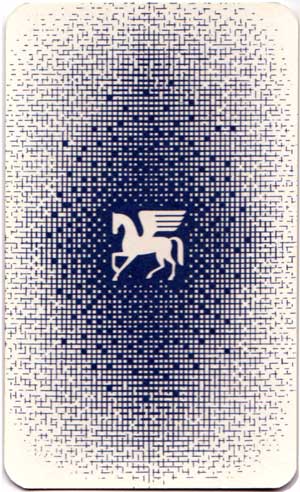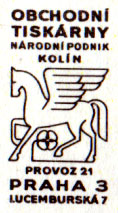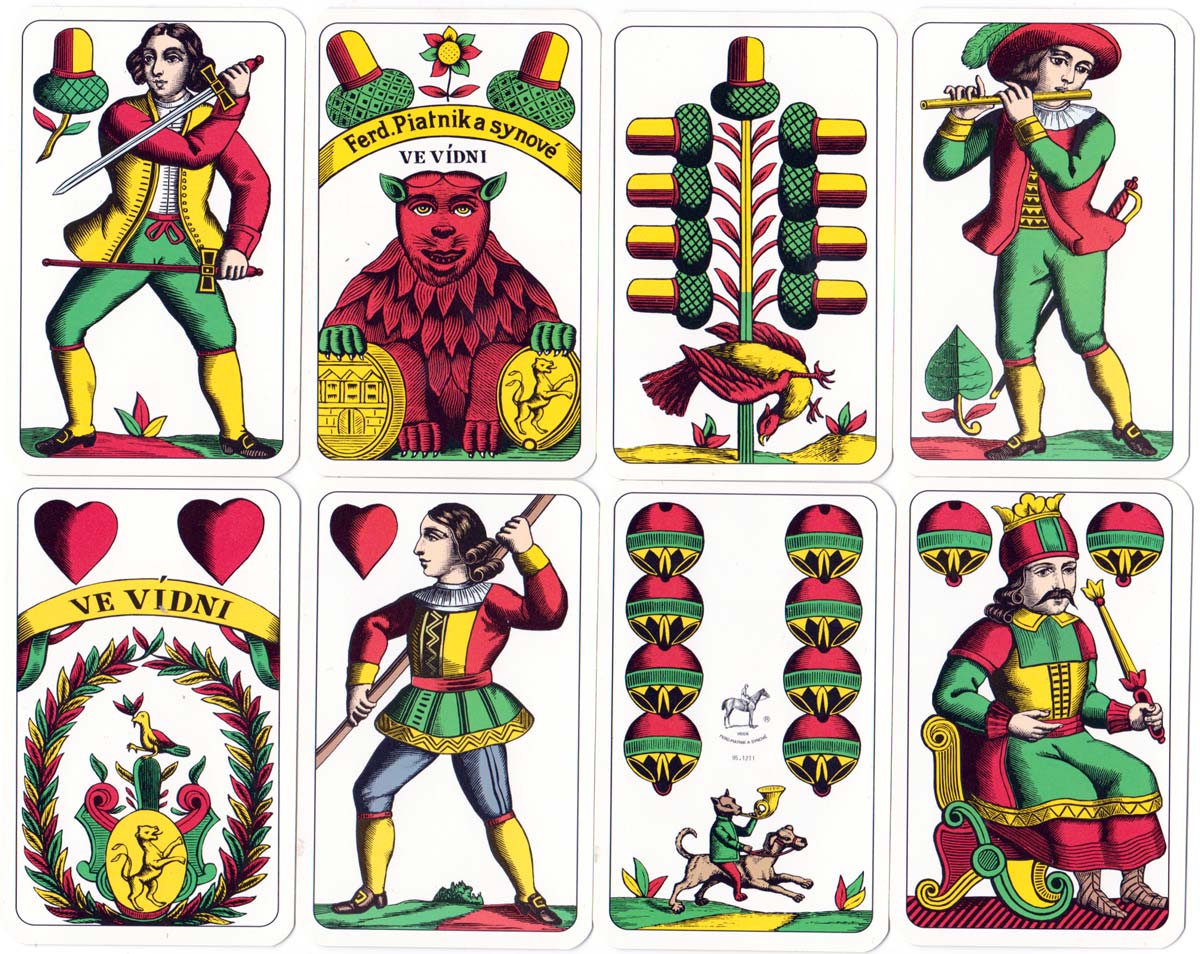Bohemian Pattern
The Bohemian Pattern, sometimes called the Prager Pattern, has roots in the 16th century.
The Bohemian pattern has roots in the 16th century
These images recall some 16th century German cards by Heinrich Hauk and others and which are also related to the Bavarian and Franconian patterns. These patterns are shared in neighbouring countries, in Austria as the Salzburger pattern and in Czechoslovakia it has become known as the Bohemian pattern. They are descended from the oldest of German-suited packs. As playing card designs were copied from workshop to workshop, characteristics from archaic models still survive today in cards such as these which have become standard patterns. The Knaves are divided into military categories and hold long spears, or halberds, swords and musical instruments. The Kings are seated and each has two suitmarks. The numeral cards have little vignettes at the bottom with animals or rural scenes.



Above: cards from Bohemian or Prager pattern, 32 cards, manufactured by Obchodní Tiskárny, Prague, Czechoslovakia, c.1970. Some of the features in this pattern originate in much earlier German cards in the 16th century. The Pegasus motif on the reverse and on the eight of bells was inherited from Ritter & Cie, Prague. Click the image to see the box→
Cards from the area which was formerly the Austro-Hungarian Empire are immensely varied. Some of them have special regional differences and are named accordingly. Just as regional dialects are spoken within different areas, similarly, regional styles of playing cards follow the fashion for certain games, ethnic groups or social classes. The Bohemian pattern, also known as the Prager pattern, shares similarities with other old German-suited patterns, such as the Bavarian and Franconian, and preserves details which have survived from the earliest days of German cardmaking, such as soldiers holding weapons and animal or burlesque vignettes on the numeral cards.
German-suited packs have tended to remove the lower numeral cards, apart from the Deuces (Twos), to reduce the number of cards from 52 to 36 or 32 cards. This is a northern custom, whereas in areas using Spanish or Italian suit systems, it is more customary to drop the 8 & 9s and to have 10, 11 & 12 as the three courts, making 40 card decks.
• See also: Czech Nationalistic • Czech 'Hussite' pack • 1908 Prague Jubilee Exhibition • 'Jugendstil' designed by Artuš Scheiner, 1920 • Ritter & Cie "Art Deco", 1933 • Eagle Playing Card Co., Ltd.
Piatnik Prager Bild

Above: the 'Prager' or 'Bohemian' pattern manufactured by Ferd Piatnik & Synové, Vienna, c.1995.

By Simon Wintle
Member since February 01, 1996
I am the founder of The World of Playing Cards (est. 1996), a website dedicated to the history, artistry and cultural significance of playing cards and tarot. Over the years I have researched various areas of the subject, acquired and traded collections and contributed as a committee member of the IPCS and graphics editor of The Playing-Card journal. Having lived in Chile, England, Wales, and now Spain, these experiences have shaped my work and passion for playing cards. Amongst my achievements is producing a limited-edition replica of a 17th-century English pack using woodblocks and stencils—a labour of love. Today, the World of Playing Cards is a global collaborative project, with my son Adam serving as the technical driving force behind its development. His innovative efforts have helped shape the site into the thriving hub it is today. You are warmly invited to become a contributor and share your enthusiasm.
Related Articles

Czech National Patterns by S.D. Modiano
Modiano produced cards with the Prague and Trappola patterns in the early 20th century.

Intersigma
A Czech advertising deck for a company dealing with pump technology.

Doppel-Deutsche Karten by Bratří Willnerové, Teplice
This deck from local manufacturer Bratří Willnerová offers a standard version of the popular Central...

French Revolutionary cards by Pinaut
Seven cards from a French Revolutionary pack by Pinaut featuring characters from classical antiquity...

Prager Pattern by Bratří Willnerové, Teplice
Traditional single-ended Prager pattern by Willner Brothers from northern Bohemia.

Ukraine playing cards
Historical figures from Ukraine’s past in a familiar Piatnik style.

Animal Skat, Česká Grafická Unie
A non-standard deck from Czechoslovakia.

Czech Bohemian style playing cards
Czech Bohemian style playing cards with a charming aesthetic, reflecting the cultural and social lif...

Play Architecture
Twentieth century architects and their creations on a well-designed pack from Finland.

Art pack I
Art pack featuring Old Masters, including Bruegel, Vermeer, Titian, Raphael, Caravaggio, Canaletto, ...

Rouen Pattern - Portrait Rouennais
An attractive XV century French-suited design from Rouen became the standard English & Anglo-America...

Austria Ski Team playing cards
Photos of members of the Austrian skiing team replace the normal courts on two different packs.

Grunwald 1410 – The Battle of Tannenberg
Details from the famous painting of the Battle of Grunwald (1410) by the Polish painter Jan Matejko....

Piatnik’s 200th Anniversary
A special philatelic souvenir for Piatnik’s 200th anniversary, combining playing cards an...

Ganjifa - Playing Cards from India
Indian playing cards, known as Ganjifa, feature intricate designs with twelve suits and are traditio...

Art pack II, Austria
Renaissance portraits by Albrecht Dürer, Lucas Cranach, Hans Holbein, Barthel Beham, Christoph Amber...
Most Popular
Our top articles from the past 28 days





